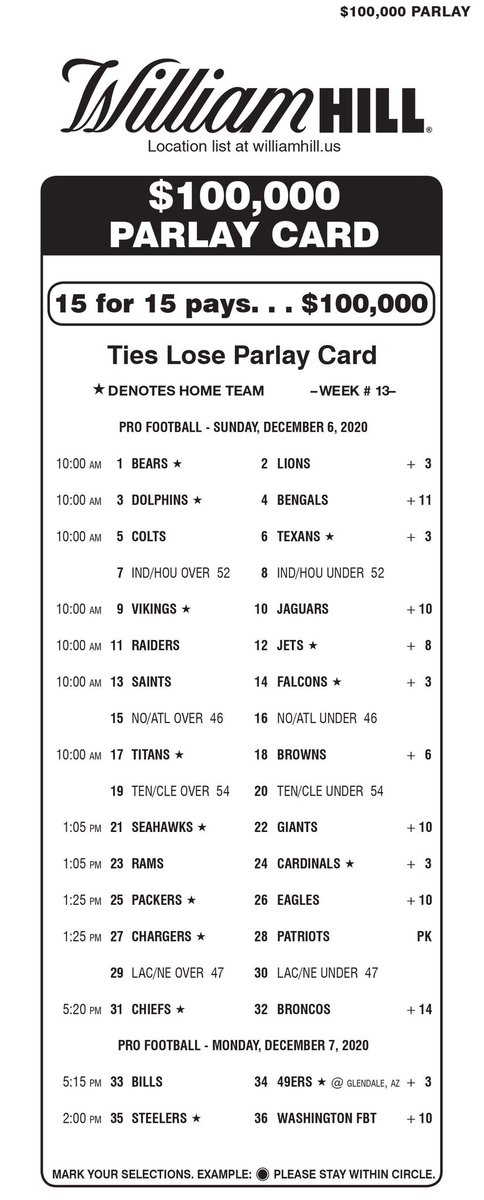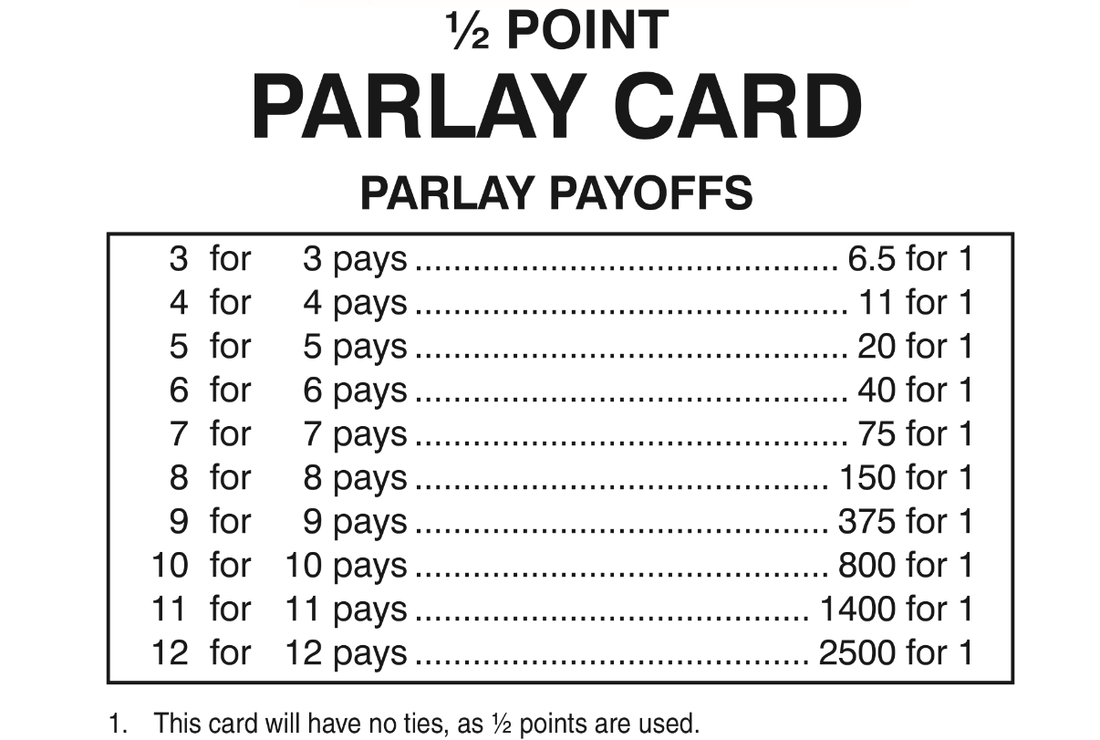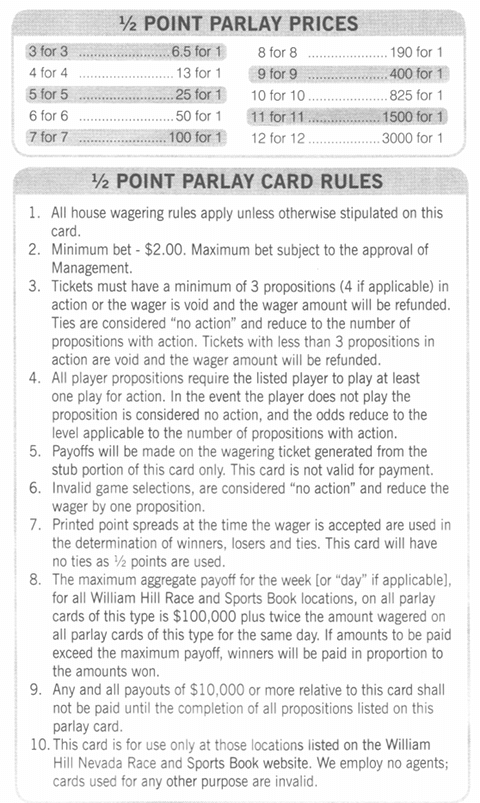Parlay Card Payouts
See All Guides
Wondering what a push is and how it will affect your sports bets? Quite simply, a push is what happens to your bet when the event you wager on results in a tie.
As bettors or competitors, we build up wins and dread losses. We’re all familiar with creeds such as “the thrill of victory and agony of defeat.” You’ve probably heard that “winning isn’t everything, it’s the only thing.”
But sometimes, sporting events are neither a win nor a loss. Overtime and shootouts have minimized the number of ties in many sports, but sometimes things still end in a draw. So, how do sportsbooks deal with these situations?
This is the factor that, when used for each leg of a parlay, gives the Pay Table payout. For a 2-team parlay at default odds, the factor is a square root. For a 3-team parlay, it is a cube root, for a 4-team parlay, it is the 4th root of the payout. The return on a 2-team Pay Table parlay at 2.6 to 1 is 3.6 for one, as the payout. The All Sport Parlay Card (also known as a Cross Sport Parlay Card) offers the opportunity to place a parlay bet on a variety of different sport-types including US and non-US sports. Log in to your account and click on PARLAY CARDS All Sport Parlay Card to display all the lines we're currently listing for use between sport types. Fast, next day payouts. No waiting days or weeks for your winnings. LEGAL and LOCAL fantasy parlay cards, from a company located in Oklahoma City. Easy to play games. Add excitement to the games you watch. Some of the best payout odds you will find. New cards added daily. Fast, next day payouts. No waiting days or weeks for your winnings. LEGAL and LOCAL fantasy parlay cards, from a company located in Oklahoma City. Easy to play games. Add excitement to the games you watch. Some of the best payout odds you will find. New cards added daily. $100 stake @ -185 = $154.05 Payout $100 stake @ -105 = $195.23 Payout. So in total you would receive $149.28 profit. Compare that to the parlay profit of $200.77, you can see why parlay betting is so appealing. The total odds of your parlay are determined by the individual odds of your bets.
In this guide you’ll learn:
- The definition of a push
- How sportsbooks deal with ties
- Ways to avoid pushes
And the Winner Is…Nobody!
Pushes happen in sports betting relatively frequently.
Say you’re betting on the NFL point spread in a match up between the Dallas Cowboys and New York Giants, and the spread is set at +/-3. Whether you bet on the Cowboys -3 or the Giants +3, there is a distinct possibility of the game ending at 17-14, 20-17, or 24-21 Dallas. Each of those scores result in a push.
Totals also result in pushes with some frequency. If the Dodgers and Nationals are playing with Clayton Kershaw and Max Scherzer on the mound, the over/under might be six. A 4-2 LA win is a victory for the Dodgers, but a push regardless of whether you had the over or under.

There are some exceptions, but most sportsbooks will take the same approach when faced with a push.
Your Bet Is a Push, Now What?
Straight wagers (also known as single bets) that result in a push are refunded. Simple and to the point, regardless of juice, if you have the Buccaneers +7 at New Orleans and the Saints win 28-21, both sides get their cash back.
If the total on Tampa Bay and New Orleans is 49, both over and under are a push and bettors who took either side will be refunded.
Moneyline bets push in the case of an actual tie. If the Patriots are -250 against Jets while New York is +240, should the teams play to a 20-20 draw, both bets are refunded.
Things get slightly more complicated when parlays and teasers are involved.
How Sportsbooks Deal with Ties in Multi-Event Wagers
Bettors can get 6/1 odds if they win a three team parlay and 12/1 for a four teamer. What happens if you win three legs of a four team wager, but the fourth bet pushes?

Most sportsbooks will simply remove any ties from a parlay or teaser and pay the bet out as if it was a multi event wager with one fewer leg. So a four team parlay with three winners and a push will pay out the same as a winning three team parlay. While you were aiming for 12/1 odds, you receive 6/1 with the push dropped from the bet.
While this policy seems like the fair and equitable way of dealing with ties, some sportsbooks treat ties included in parlays and teasers as losing bets. This is particularly common on parlay cards produced early in the week that remain available for betting all the way up to kickoff on Saturday or Sunday.
The bottom line is that you should always read the small print. Know exactly how your sportsbook deals with pushes before you place a bet.
Of course, you’re more likely to be faced with a push in your parlay if you include a higher number of legs in the wager. A 10 team parlay has 10 chances for a push, whereas a two team parlay involves only two games that could possibly tie.
What Do You Get Out of a Push?
If you’re always in it to win it, it is possible to avoid pushes completely. If you spent time to watch a long sporting event and put a few bucks down, it can feel like a waste to get refunded if the game ends in a tie. On the flip side, a tie certainly beats a loss if you are a high volume better primarily concerned with ROI.
The easiest way to avoid pushes is to bet on spreads that include a half point, also known as a hook. There will never be a push with a 2.5 or 3.5 spread or a total of 47.5. If you can’t find a spread or total with a hook, you can usually buy a half point. You might pay a small price in juice, but it usually makes sense to take -125 to get -2.5 instead of -110 when laying three.
While moneyline bets occasionally push, it doesn’t happen a lot. There are no ties in the NBA, NHL, or MLB these days. The NFL had one tie last year, two in 2018, and none in 2017. The chances of a push when playing the moneyline in major sports is very small.
Finally some sports, particularly soccer, offer three way betting. You can bet on either team to win or on a tie. Just remember that if you pick a team to win on a three way moneyline, a push will result in a loss rather than a refund.
Go for the Win, Settle for the Push
In the end, a push is not a bad result. It gives you a free data point to consider and learn from. Of course, that only holds true if your sportsbook refunds your bet in the case of a push. Read the terms and conditions carefully before placing any wagers.
Knowing is the key to success when betting on sports. You can find all the basic info you need to get started on the right foot in our sports betting 101 guides.
A parlay is a type of wager where multiple outcomes are selected. Each of the outcomes must win in order for the parlay to win. Any point spread tie reduces to the next lowest number of teams in the parlay. The odds for the number of teams placed in a parlay are based on the pay table below when the selections (point spreads and totals for football and basketball, games and segments) have a default line of -110. Listed below is the BetMGM/Borgata Online pay table.
All Football and Basketball Parlays
(Point Spreads and Totals all - 110)
2 Teams | +260 |
3 Teams | +600 |
4 Teams | +1000 |
5 Teams | +2000 |
6 Teams | +4000 |
7 Teams | +8000 |
8 Teams | +15000 |
9 Teams | +30000 |
10 Teams | +60000 |
11 Teams | +110000 |
| 12 Teams | +200000 |
| 13 Teams | +300000 |
| 14 Teams | +600000 |
| 15 Teams | +1000000 |
Parlay Odds Selections:
The legs in a Pay Table parlay all must meet the following requirements:
- Football, basketball (excluding money lines) and their halves or quarters
- Point spread or totals
- Default odds that are set at -110.
Maximum payoff on off the board parlays is 10000/1. Acceptance of all parlays is at the discretion of management.
Example 1: The 2-team parlay (See picture below) is a standard parlay paying 2.6 to 1 or 3.6 for 1. Using the Pay Table, $10.00 x 3.6 = $36.00 payout. Pay Table parlays are not calculated using “true odds” (-110 is not .9091 in this case). The Pay Table Multiplier section below explains the way that Pay Table odds are calculated.
PARLAY (2 TEAMS) | |
|---|---|
1 PARLAY @$10.00 | |
24Jan PRO FOOTBALL | |
[302] COLTS | -71/2-110 |
22Jan PRO BASKETBALL | |
[702] BOBCATS | -6-110 |
Ticket Cost: | $10.00 |
To Win: | $26.00 |
Collect: | $36.00 |
WRIT2 SR_POS2 | 22Jan18 11:02:40 |
Pay Table Multiplier
This is the factor that, when used for each leg of a parlay, gives the Pay Table payout. For a 2-team parlay at default odds, the factor is a square root. For a 3-team parlay, it is a cube root, for a 4-team parlay, it is the 4th root of the payout.
The return on a 2-team Pay Table parlay at 2.6 to 1 is 3.6 for one, as the payout. The square root of 3.6 is 1.8974. This is the Pay Table Multiplier for 2-team parlays.
$10 X 1.89736 X 1.89736 = 36.00.

Below is the pay table multiplier which is used as the method to calculate pay table parlays when the default odds are -110.The respective Pay Table Multiplier (shown below) by the True Odds Multiplier of the number (other than -110) minus the True Odds Differential (shown below).
2 Teams | 1.89736 |
3 Teams | 1.91293 |
4 Teams | 1.82116 |
5 Teams | 1.83841 |
6 Teams | 1.85693 |
7 Teams | 1.87344 |
8 Teams | 1.87228 |
9 Teams | 1.88536 |
10 Teams | 1.89621 |
11 Teams | 1.89027 |
| 12 Teams | 1.88409 |
| 13 Teams | 1.87339 |
| 14 Teams | 1.86154 |
| 15 Teams | 1.84786 |
Non-Pay Table Parlays
We use the term Non-Pay Table parlay when at least one leg does not meet requirements 1 and/or 2 of the Pay Table parlay default odds section above.
Sports like Boxing, Baseball, and Hockey use Non-Pay Table Odds. Football money line bets also use them. The True Odds Multiplier section below explains the way that Non Pay Table odds are calculated.
Example 2: The 2-team parlay below uses the True Odds Multiplier because neither leg meets the Pay Table requirements, so $10 x 1.9091 x 1.9091 (rounded) = $36.45 payout.
PARLAY (2 TEAMS) | |
|---|---|
1 PARLAY @$10.00 | |
30Jan PRO HOCKEY | |
[2] CAPITALS | -110 |
28Jan BOXING | |
[3605] MAYWEATHER | -110 |
Ticket Cost: | $10.00 |
To Win: | $26.45 |
Collect: | $36.45 |
WRIT2 SR_POS2 | 22Jan18 16:26:24 |
Example 3: The 2-team parlay below uses the Pay Table Multiplier for 105 because it meets all other requirements for Pay Table Odds (see Pay Table Parlays above). Note: The root for the Pay Table Multiplier is based on only the number of legs that meet the requirement. It usesthe True Odds Multiplier for 107 (-1/-120 = .8333) because that leg does not meet requirement 2. Although it is a Football game, it is a money line wager.
$10 x 1.9091 x 1.8333 = $35 payout.
PARLAY (2 TEAMS) | |
|---|---|
1 PARLAY @$10.00 | |
Jan 08 NFL | |
| NFL WILDCARD PLAYOFFS | |
[105] FALCONS | +3-110 |
Jan 08 NFL | |
| NFL WILDCARD PLAYOFFS | |
[107] STEELERS | -120 |
Ticket Cost: | $10.00 |
To Win: | $25.00 |
Collect: | $35.00 |
TIMW BODINES T01 | 5Jan18 09:35:56 |
Pay Table Non-Default Odds
We use the term Pay Table Non-Default Odds when all legs meet requirements 1 and 2 of a Pay Table parlay: 1) Football, basketball, and their halves or quarters 2) Point spread or totals, but at least one leg does not meet requirement 3 because it hasodds that are not equal to the default odds.
Pay Table Non-Default parlays are not calculated using “true odds” (-120 is not .8333). The True Odds Differential section below explains the way that Pay Table Non-Default odds are calculated.
Example 4: The 2-team parlay below uses the Pay Table Multiplierfor default odds for 302 (which meets all the requirements of a Pay Table parlay like Example 1 above). However, the other leg (304 Saints) has non-default odds -120, so a factor called the True Odds Differential is used to adjust the True Odds Multiplier of the -120 to derive the new Pay Table Multiplier for non-default odds -120.
$10 x 1.8974 x 1.8216 = $34.56 (rounded to nearest nickel $34.55)
PARLAY (2 TEAMS) | |
|---|---|
1 PARLAY @$10.00 | |
24Jan PRO FOOTBALL | |
[302] COLTS | -71/2-110 |
22Jan PRO FOOTBALL | |
[304] SAINTS | -3-120 |
Ticket Cost: | $10.00 |
To Win: | $24.55 |
Collect: | $34.55 |
WRIT2 SR_POS2 | 22Jan18 11:03:11 |
True Odds Differential
The only time that the True Odds Differential is used is when a leg contains a Pay Table sport that has non-default odds for point spread or totals (Example 4 above has -3-120 instead of -3 -110).
Calculating the True Odds Differential for a Non-Default Odds leg when default odds = -110
(True Odds Multiplier of -110) - (Pay Table Multiplier of -110) = True Odds Differential
1.9091 - 1.8974 = .0117
Super Teaser Parlay Card Payouts
Calculation to find the Pay Table Multiplier for Non-Default odds -120 in Example 4
True Odds Multiplier of -120 = 1.8333 – True Odds Differential = . 0117
Pay Table Multiplier of -120 = 1.8216
The only exception for not using the true odds differential is when the pay table multiplier exceeds that of true odds (-110 or .9091).
Calculations to find the True Odds Multiplier
When the Leg is a Favorite
When laying odds (money line is less than 0): (-1) x (100)/ (money line) +1.
Example: True Odds Multiplier for Money line: -110: (-1) x ((100)/ (-110)) +1 = 1.9091
When the Leg is an Underdog
Delaware Parlay Card Payouts
When taking odds (money line is greater than 0): (money line)/ (100) +1 Example:
True Odds Multiplier for Money line: +130 = ((+130) /(100)) +1 = 2.3